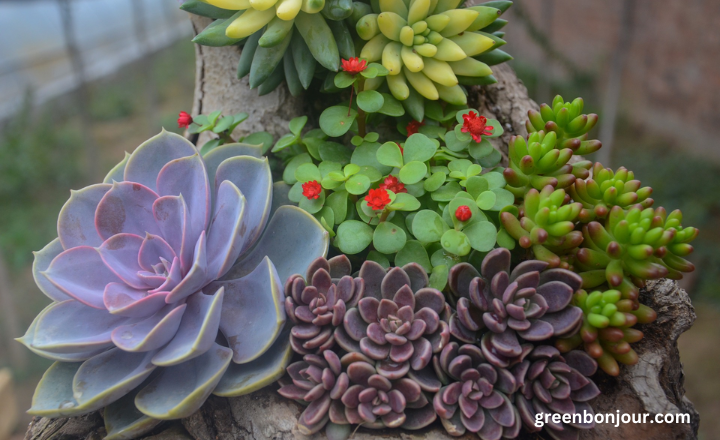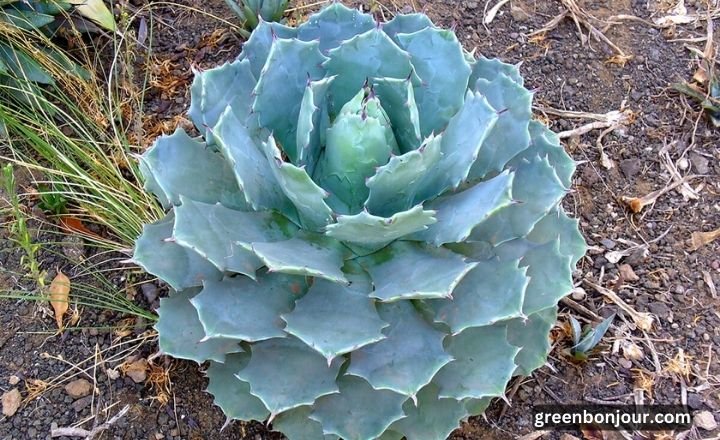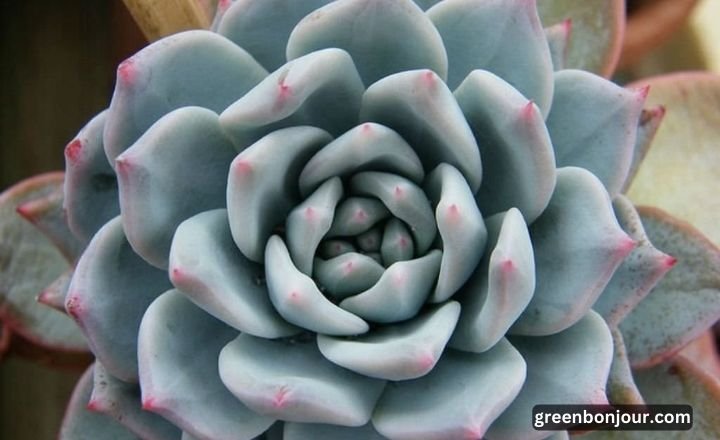Blue succulents are considered the most famous of all. It has pretty colors like bluish and dark blue with some red corners. Succulents exist in a wide range. The succulent plants have different sizes, shapes, and colors. You can have different collections such as Tiger Jaws Succulent, Blue Elf Succulent, Moonglow Succulent, Manfreda Succulent, Graptoveria Succulent, etc.
They create the perfect foil for other varieties and give a cool aspect to a dish garden and outdoor space. If you want to bring in blue succulent varieties to your collection you need to learn about them because they demand high maintenance and care.
What are Blue Succulent plants?
Blue succulent plants are unique and eye-catching additions to any garden or indoor space. These plants get their blue coloration from a wax coating on their leaves, which helps protect them from harsh sunlight and drought conditions.
Blue succulents evoke a sense of tranquility and coolness, making them ideal for creating a calming atmosphere in any space. Their distinctive color adds an element of intrigue and sophistication, making them a must-have for any succulent enthusiast looking to add a pop of color to their collection. You should know that by growing them you can have the following benefits:
- You can grow them because they can survive without water for weeks.
- They are lasting plants, you will love them.
- They show amazing patterns on their leaves.
- They are attractive and attract people’s attention.
- They are fireproof.

A few varieties of Blue Succulents
You need to know about different varieties of them:
- Agave potatorum (Butterfly Agave)
- Echeveria ‘Blue Prince’
- Agave tequilana (Blue Agave)
- Senecio Mandraliscae (Blue Chalksticks)
- Echeveria ‘Blue Bird’
- Sedum reflexum (Blue Spruce Stonecrop)
- Aloe ‘Blue Sky’
- Sedeveria ‘Blue Burrito’
Agave potatorum
- The striking blue hue of the agave potatorum, also known as Butterfly Agave.
- This adds an enchanting touch to any garden or landscape.
- This succulent’s unique coloration makes it different from other species.
- This variety is making it a sought-after addition for plant enthusiasts seeking a pop of color.
- The buttery texture of its leaves makes it attractive because of its elegant curves and intricate patterns it.
- The agave potatorum is known for its resilience and low maintenance requirements.
- This can be the best choice for both experienced and beginners as well to grow.
- Its drought-tolerant nature and ability to thrive in various climates make it a versatile option for landscaping projects.
- With proper care and suitable growing conditions, this stunning succulent can flourish and provide a delightful visual treat year-round.

Echeveria ‘Blue Prince’ Highlights
- The second verity is Blue Prince.
- They grow unique dark blue-green flowers.
- Their color changes after some time when they become mature.
- They have a tall bloom stalk that produces pink flowers during the spring season.
- You can propagate them using leaf and stem cuttings.
- They are hardy plants so they used to grow in hardy 10 zones.
- You need to make sure the temperature doesn’t drop below 35° F.
Agave tequilana (Blue Agave)
- They are also known as Blue Agave.
- They grow up to medium size.
- They reach the height of 5’ x 5’ when they get mature.
- They prefer full sun, so you need to give them full sun for their best growth.
- They require medium to low amounts of water.
- The flower color can attract Birds, Butterflies, and Deer Resistant.
- They are best grown in hardiness zone 9-11.

Senecio Mandraliscae (Blue Chalksticks)
- This is another variety but it has many names.
- Its common names are Senecio Mandraliscae such as Blue Chalk Sticks, Blue Finger, and Kleinia.
- It belongs to the Asteraceae family and originated from South Africa.
- They reach a particular height of 1’ -2’.
- But their width is 2’-3’.
- They can survive in cold temperatures such as 10 to 15 F.
- They want full sun and they can survive in partial sunlight as well so you need to give so.
Echeveria ‘Blue Bird’
- This is also called a Bluebird.
- They prefer bright light, so you need to provide them with bright light.
- But you need to take care of it so that you have to avoid direct sunlight because they can’t bear it.
- A watering schedule is necessary to follow.
- Make sure water does not sit on the water and avoid overwatering the plant.
- You need to add a ratio of charcoal soil, perlite, and coarse river sand.
- Temperature should be maintained.
- The plant can grow at a normal household humidity level.

Sedum reflexum (Blue Spruce Stonecrop)
- This plant is also called Blue Spruce Stonecrop.
- They used to bloom in blue and blur green flowers.
- They are best grown in hardiness zone 4.
- They prefer full sun to grow quickly.
- They reach the height of 3’-5’.
- They are used to bloom in summer, year-round.
- They come under fast-growing, easy-to-propagate, and pet-safe plants.
How do you grow the Blue Succulent plants?
Growing blue succulent plants can be rewarding and it can be a striking addition to any indoor or outdoor space. To successfully cultivate these unique plants, make sure that they receive plenty of sunlight, as they thrive in bright conditions. Proper watering is crucial – allow the soil to dry out completely between waterings to prevent root rot.
You need to use a well-draining mixture specifically designed for succulents to accommodate the plant’s needs. Blue succulents also benefit from occasional fertilization during their growing season to promote healthy growth and beautiful coloration. By following these care tips and providing the right conditions, you can enjoy the beauty of blue succulent plants in your own home or garden.
How do you care for the Blue Succulent plants?
Blue succulent plants are unique and you can grow them in addition to any plant collection, but they require specific care and attention. These plants, like other succulents, appreciate well-draining soil and plenty of sunlight. It is essential to protect them from intense afternoon sun exposure as this can cause their vibrant blue color to fade.
To maintain the striking hue of these plants, it’s crucial to provide moderate amounts of water, allowing the soil to dry out between waterings. One interesting care tip for blue succulents is that they benefit from occasional misting during periods of low humidity. This extra moisture helps keep their leaves healthy and prevents drying out or browning.
You need to use fertilizer can provide necessary nutrients without overwhelming the plant. By following these simple care guidelines and paying close attention to their needs, you can enjoy the beauty of your blue succulent plants for years to come.
Conclusion
Blue succulents are considered the most famous of all. It has pretty colors like bluish and dark blue with some red corners. Succulents exist in a wide range. The succulent plants have different sizes, shapes, and colors.
They create the perfect foil for other varieties and give a cool aspect to a dish garden and outdoor space. If you want to bring in blue succulent varieties to your collection you need to learn about them because they demand high maintenance and care.
FAQs
Why do succulents turn blue?
Depending on how much sunlight a succulent receives throughout the day, its colors can change to adapt. Large amounts of sunlight will cause “light stress” and lead to succulents changing color to compensate for this stress.
Do succulents need darkness?
Most succulents do best in bright direct light and need at least 6 hours of natural light per day.